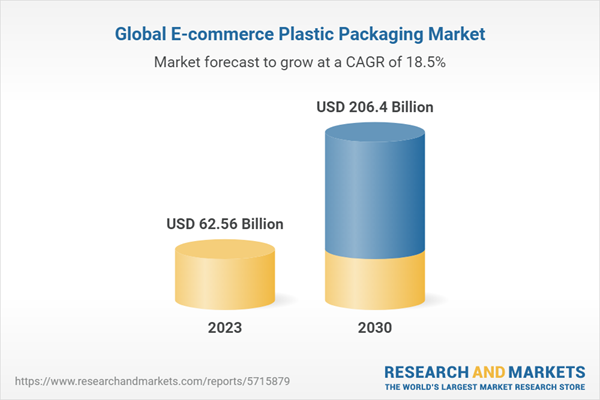Speak directly to the analyst to clarify any post sales queries you may have.
The Cumulative Impact of COVID-19, the Russia-Ukraine Conflict, and High Inflation is expected to have significant long-term effects on the Global E-commerce Plastic Packaging Market. The ongoing research considers the changes in consumer behavior, supply chain disruptions, and government interventions caused by the pandemic. Similarly, the report considers the ongoing political and economic uncertainty in Eastern Europe caused by the Russia-Ukraine Conflict and its potential implications for demand-supply balances, pressure on pricing variants, and import/export and trading. Additionally, the report addresses the impact of High Inflation on the global economy and details fiscal policies measuring and reducing its effects on demand, supply, cash flow, and currency exchange.
Market Segmentation & Coverage:
This research report categorizes the Global E-commerce Plastic Packaging Market in order to forecast the revenues and analyze trends in each of following sub-markets:- Based on Product, the market is studied across Pouches & Bags, Protective Packaging, and Shrink Films. The Protective Packaging is projected to witness significant market share during forecast period.
- Based on End-User, the market is studied across Consumer & Electronics, Fashion & Apparels, Food & Beverages, and Personal Care Products. The Consumer & Electronics is projected to witness significant market share during forecast period.
- Based on Region, the market is studied across Americas, Asia-Pacific, and Europe, Middle East & Africa. The Americas is further studied across Argentina, Brazil, Canada, Mexico, and United States. The United States is further studied across California, Florida, Illinois, New York, Ohio, Pennsylvania, and Texas. The Asia-Pacific is further studied across Australia, China, India, Indonesia, Japan, Malaysia, Philippines, Singapore, South Korea, Taiwan, Thailand, and Vietnam. Europe, Middle East & Africa is further studied across Denmark, Egypt, Finland, France, Germany, Israel, Italy, Netherlands, Nigeria, Norway, Poland, Qatar, Russia, Saudi Arabia, South Africa, Spain, Sweden, Switzerland, Turkey, United Arab Emirates, and United Kingdom. Europe, Middle East & Africa is projected to witness significant market share during forecast period.
Market Statistics:
The report provides market sizing and forecasts across 7 major currencies - USD, EUR, JPY, GBP, AUD, CAD, and CHF; multiple currency support helps organization leaders to make well-informed decisions. In this report, 2018 to 2021 are considered as historical years, 2022 is base year, 2023 is estimated year, and years from 2024 to 2030 are considered as forecast period.FPNV Positioning Matrix:
The FPNV Positioning Matrix is essential for assessing the Global E-commerce Plastic Packaging Market. It provides a comprehensive evaluation of vendors by examining key metrics within Business Strategy and Product Satisfaction, allowing users to make informed decisions based on their specific needs. This advanced analysis then organizes these vendors into four distinct quadrants, which represent varying levels of success: Forefront (F), Pathfinder (P), Niche (N), or Vital(V).Market Share Analysis:
The Market Share Analysis offers an insightful look at the current state of vendors in a particular market space. By comparing vendor contributions to overall revenue, customer base, and other key metrics, we can give companies a greater understanding of their performance and what they are up against when competing for market share. The analysis also sheds light on just how competitive any given sector is about accumulation, fragmentation dominance, and amalgamation traits over the base year period studied.The report provides insights on the following pointers:
- Market Penetration: Provides comprehensive information on the market offered by the key players
- Market Development: Provides in-depth information about lucrative emerging markets and analyzes penetration across mature segments of the markets
- Market Diversification: Provides detailed information about new product launches, untapped geographies, recent developments, and investments
- Market Trends: Provides comprehensive understanding of the Cumulative Impact of COVID-19, the Russia-Ukraine Conflict, and the High Inflation
- Competitive Assessment & Intelligence: Provides an exhaustive assessment of market shares, strategies, products, certification, regulatory approvals, patent landscape, and manufacturing capabilities of the leading players
- Product Development & Innovation: Provides intelligent insights on future technologies, R&D activities, and breakthrough product developments
The report answers questions such as:
- What is the market size and forecast of the Global E-commerce Plastic Packaging Market?
- What are the inhibiting factors and impact of COVID-19 shaping the Global E-commerce Plastic Packaging Market during the forecast period?
- Which are the products/segments/applications/areas to invest in over the forecast period in the Global E-commerce Plastic Packaging Market?
- What is the competitive strategic window for opportunities in the Global E-commerce Plastic Packaging Market?
- What are the technology trends and regulatory frameworks in the Global E-commerce Plastic Packaging Market?
- What is the market share of the leading vendors in the Global E-commerce Plastic Packaging Market?
- What modes and strategic moves are considered suitable for entering the Global E-commerce Plastic Packaging Market?
Additional Product Information:
- Purchase of this report includes 1 year online access with quarterly updates.
- This report can be updated on request. Please contact our Customer Experience team using the Ask a Question widget on our website.
Table of Contents
Companies Mentioned
- ALPLA Group
- Amcor PLC
- Berry Global Inc.
- CCL Industries Inc.
- Clondalkin Flexible Packaging
- Constantia Flexibles
- Gerresheimer AG
- Greif, Inc.
- Huhtamaki Oyj
- Mondi PLC
- Pregis LLC
- Sealed Air Corporation
- Silver Spur Corp.
- Sonoco Products Company
- Storopack Hans Reichenecker GmbH
- Transcontinental Inc.
- WINPAK Ltd.
Methodology

LOADING...
Table Information
| Report Attribute | Details |
|---|---|
| No. of Pages | 180 |
| Published | March 2024 |
| Forecast Period | 2023 - 2030 |
| Estimated Market Value ( USD | $ 62.56 Billion |
| Forecasted Market Value ( USD | $ 206.4 Billion |
| Compound Annual Growth Rate | 18.5% |
| Regions Covered | Global |
| No. of Companies Mentioned | 17 |









